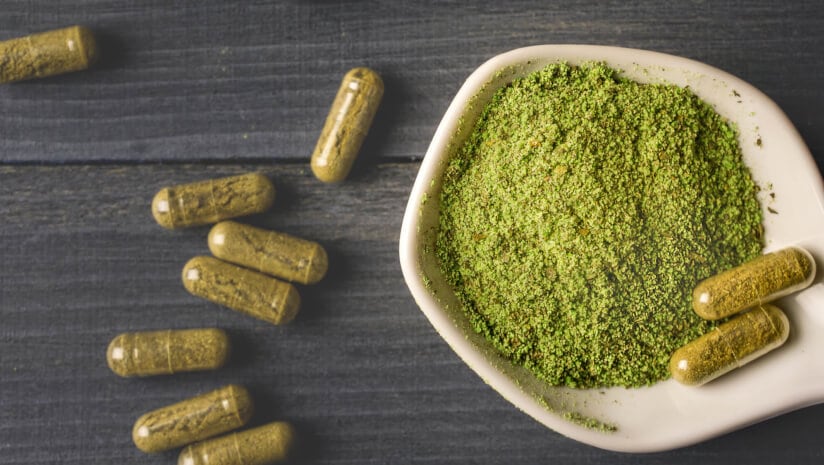The Scientific Association for Botanical Education and Research (SABER) is a non-profit comprised of scientists from U.S. and Canadian institutions who conduct research on kratom, the common name for a species of tree grown in Southeast Asia.
7-OH exists in low levels in the kratom leaf, but a man-made chemical alteration to the leaf’s naturally occurring alkaloids can increase 7-OH levels. For the last year, there has been a proliferation of synthetic products sold in convenience stores and online with high amounts of 7-OH.
Synthetic 7-OH is up to 13 times more potent than morphine at opioid receptors, significantly increasing the risk of dependence and overdose, said Dr. Paula Brown, director of the BC Institute of Technology’s Natural Health and Food Products Research Group (NRG) in a statement. She is also a SABER steering committee member.
“Synthetic 7-OH is not kratom—it is a highly potent, unregulated chemical,” she said. “Consumers have a right to transparency, yet these products are often mislabeled and marketed deceptively as natural extracts, without proper quality and safety testing, they carry a significant risk of causing harm”.
Kratom
For centuries, kratom leaves have been used traditionally to combat fatigue, treat pain and boost energy not only among Asian consumers but also in Africa and the Pacific islands.
According to the Cleveland Clinic, low doses of kratom can act as a stimulant and make users more alert. Higher doses can be sedating and possibly offer relief from intense pain.
In the last few decades, kratom’s use has grown in popularity in the United States. A 2022 national survey by the U.S. Department of Health and Human Services estimated more than 1.9 million people use kratom.
The U.S. Food and Drug Administration cautions that kratom can, dependent on the dose, cause potential harm, including liver toxicity, seizures and substance use disorder. Although kratom has been banned in numerous states, several bills have been introduced in Congress to protect access to kratom.
Last year, the FDA concluded a pilot study on the substance in which participants received anywhere from 1 g to 12 g of kratom. The scientists tracked blood pressure, pulse, respiratory rate and body temperature to monitor for any adverse events.
“The FDA study that used our kratom found it was generally well-tolerated with no serious adverse events at significantly elevated doses (beyond what we would recommend),” said Ken Loricchio, co-founder of kratom supplier Super Speciosa. “While we recognize the FDA’s concerns, the study highlights kratom’s potential for responsible use when sourced and used properly. It’s worth noting that, like many foods and supplements, kratom carries risks when misused.”
He said that it is crucial to continue to inform lawmakers about what kratom is and how it is used and that it is important for kratom suppliers to clearly label their products.
“Many lawmakers are still making decisions based on outdated information from 2012, which inaccurately compared kratom to bath salts,” he added. “Sensible regulation tends to prevail when advocacy groups have the chance to educate lawmakers. For example, we haven’t seen any new state bans in several years, and we anticipate that existing bans will be overturned in favor of a regulated market.”
Some argue that kratom should be regulated as a dietary supplement, though the FDA has a different position.
The FDA stated that, “kratom is not appropriate for use as a dietary supplement. FDA has concluded from available information, including scientific data, that kratom is a new dietary ingredient for which there is inadequate information to provide reasonable assurance that such ingredient does not present a significant or unreasonable risk of illness or injury and, therefore, dietary supplements that are or contain kratom are adulterated under section 402(f)(1)(B) of the FD&C Act.”
Synthetic ‘kratom’
Loricchio said he noticed that 7-OH, or synthetic ‘kratom,’ started to increase in the marketplace last year.
According to researchers, this is because “[7-OH] product marketing fails to distinguish itself from kratom. Kratom-naïve consumers purchasing 7-hydroxymitragynine products may erroneously believe that they are relatively safe ‘natural’ products similar or identical to kratom products that have been used in the United States for at least two decades.”
SABER, the new advocacy and research organization, seeks to fight that misinformation.
“Our mission is to protect legitimate nootropics from affiliation with harmful substances—we consider any adulterated product a potential threat to public health,” Thomas Brendler, a scientist, regulatory consultant and member of SABER’s steering committee, told NutraIngredients-USA.
In addition to Drs. Brown and Brendler, other committee members include Dr. Mary L. Hardy, a medical doctor with expertise in safety assessment of botanicals and adverse event reporting, and Dr. Simon Mills, an expert in herbal medicine and education in appropriate use.
“The academic and scientific leaders of the organization are the foremost experts on botanical products in the world,” said Matthew Lowe, executive director of the Global Kratom Coalition, which is not affiliated with SABER. “Specific to kratom, it is paramount that regulation on a state and national level in the U.S. is backed and driven by science. Of significant concern to the Global Kratom Coalition is the proliferation of 7-hydroxymitragynine products. These high concentrate isolate products have recently become available to consumers, are being mislabeled as kratom and are masquerading as dietary supplements.”
The FDA says 7-OH products can cause sedation, nausea/vomiting, constipation, physical dependence/withdrawal and respiratory depression that may lead to death.


